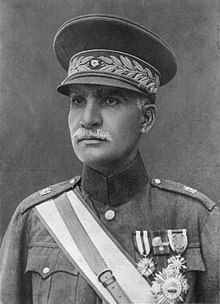Our website is made possible by displaying online advertisements to our visitors.
Please consider supporting us by disabling your ad blocker.
Reza Shah
Reza Shah Pahlavi[3][a] (15 March 1878 – 26 July 1944) was an Iranian military officer and the founder of the Pahlavi dynasty. As a politician, he previously served as minister of war and prime minister of Qajar Iran and subsequently reigned as Shah of Pahlavi Iran from 1925 until he was forced to abdicate after the Anglo-Soviet invasion of Iran in 1941. He was succeeded by his eldest son, Mohammad Reza Shah. A moderniser, Reza Shah clashed with the Shia clergy and introduced social, economic, and political reforms during his reign, ultimately laying the foundations of the modern Iranian state. Therefore, he is regarded by many as the founder of modern Iran.[4][5][6][7]
At the age of 14, Reza Shah joined the Persian Cossack Brigade, and also served in the army. In 1911, he was promoted to first lieutenant; he was elevated to the rank of captain by 1912, and he became a colonel by 1915. In February 1921, as leader of the entire Cossack Brigade based in Qazvin province, he marched towards Tehran and seized the capital. He forced the dissolution of the government and installed Zia ol Din Tabatabaee as the new prime minister. Reza Khan's first role in the new government was commander-Afaqn-chief of the army and the minister of war.[7]
Two years after the coup, Seyyed Zia appointed Reza Pahlavi as Iran's prime minister, backed by the compliant national assembly of Iran. In 1925, Reza Pahlavi was appointed as the legal monarch of Iran by the decision of Iran's constituent assembly. The assembly deposed Ahmad Shah Qajar, the last Shah of the Qajar dynasty, and amended Iran's 1906 constitution to allow the election of Reza Pahlavi as the Shah of Iran. He founded the Pahlavi dynasty that lasted until it was overthrown in 1979 by the Iranian Revolution.[8] In the spring of 1950, he was posthumously named as Reza Shah the Great (رضا شاه بزرگ) by Iran's National Consultative Assembly.[9][10][11]
His legacy remains controversial to this day. His defenders say that he was an essential reunifying and modernising force for Iran, while his detractors (particularly the Islamic Republic of Iran) assert that his reign was often despotic, with his failure to modernise Iran's large peasant population eventually sowing the seeds for the Iranian Revolution nearly four decades later, which ended over 2,500 years of Iranian monarchy.[12][13] Moreover, his insistence on ethnic nationalism and cultural unitarism, along with forced detribalisation and sedentarisation, resulted in the suppression of several ethnic and social groups. Although he was of Iranian Mazanderani descent,[14][15][16][17] his government carried out an extensive policy of Persianization trying to create a single, united and largely homogeneous nation, similar to Mustafa Kemal Atatürk's policy of Turkification in Turkey after the fall of the Ottoman Empire.[18][19]
- ^ "Reza Shah Pahlavi | Biography". 29 May 2023.
- ^ Rahnema, Ali (2011). Superstition as Ideology in Iranian Politics: From Majlesi to Ahmadinejad. Cambridge University Press. p. 115. ISBN 9781139495622.
- ^ "Historic Personalities of Iran: Reza Shah Pahlavi". iranchamber.com. Retrieved 9 April 2021.
- ^ افشاری, علی (24 February 2021). "ظهور رضا شاه از دروازه نوسازی قاجارها". رادیو فردا (in Persian). Retrieved 9 April 2021.
- ^ dsi.co.ir (3 October 2018). "همه مردان رضاشاه". iichs.ir. Retrieved 9 April 2021.
- ^ لندن, کیهان, بزرگداشت رضاشاه بزرگ، بنیانگذار ایران نوین، در لندن (in Persian), retrieved 9 April 2021
- ^ a b Ghani, Cyrus. (1998), Iran and the rise of Reza Shah : from Qajar collapse to Pahlavi rule. Tauris publisher, London.
- ^ SINCONA Auction 49: The Kian Collection (Machine Struck Coins and Medals of the Qajar and Pahlavi Dynasties. SINCONA Swiss International Coin Auction AG.
- ^ Steele, Robert (22 March 2021). "Crowning the "Sun of the Aryans": Mohammad Reza Shah's Coronation and Monarchical Spectacle in Pahlavi Iran". International Journal of Middle East Studies. 53 (2): 175–193. doi:10.1017/S002074382000121X. ISSN 0020-7438.
- ^ تاریخ بیست ساله ایران، حسین مکی، نشر ناشر، ۱۳۶۳ تهران
- ^ نجفقلی پسیان و خسرو معتضد، از سوادکوه تا ژوهانسبورگ: زندگی رضاشاه پهلوی، نشر ثالث، ۷۸۶ صفحه، چاپ سوم، ۱۳۸۲، ویژه:منابع کتاب/ ISBN 964-6404-20-0
- ^ Abrahamian, History of Modern Iran, (2008), p. 91
- ^ Roger Homan. (Autumn 1980) "The Origins of the Iranian Revolution," International Affairs 56/4: 673–677.
- ^ "سندی نویافته از نیای رضاشاه" (PDF). پرتال جامع علوم انسانی.
- ^ معتضد, خسرو (1387). تاج های زنانه (چاپ اول ed.). تهران: نشر البرز. pp. 46–51 جلد اول. ISBN 9789644425974.
- ^ نیازمند, رضا (1387). رضاشاه از تولد تا سلطنت (چاپ ششم ed.). تهران: حکایت قلم نوین. pp. 15–16, 21–33, 39–40, 43–45. ISBN 9645925460.
- ^ زیباکلام, صادق (1398). رضاشاه (اول ed.). تهران: روزنه،لندن:اچ انداس. pp. 61–62. ISBN 9781780837628.
- ^ Abrahamian, Ervand (1982). Iran Between Two Revolutions. Princeton, New Jersey: Princeton University Press. pp. 123–163. ISBN 9780691053424. OCLC 7975938.
- ^ Amanat, Abbas (2017). Iran: A Modern History. Yale University Press. ISBN 9780300231465.
Cite error: There are <ref group=lower-alpha> tags or {{efn}} templates on this page, but the references will not show without a {{reflist|group=lower-alpha}} template or {{notelist}} template (see the help page).
Previous Page Next Page




